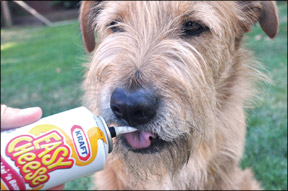Many of us have dogs who bite down too hard when taking treats – the behavior sometimes known as “hard mouth.” Some dogs take treats forcefully all the time; others get hard mouths only when stressed or excited. One theory is that a hard mouth is a function of bite inhibition – or lack thereof. If a dog doesn’t learn to use his mouth softly during puppyhood, he’s likely to resort to using too much pressure with his mouth throughout his life. But some dogs with acceptably soft mouths take treats hard when stressed or excited. Here are five things you can do when facing a “hard mouth” challenge:

288
1. Teach remedial bite inhibition (see “Light Bite,” WDJ June 2010). Even though this may not get you through the higher arousal situations with your fingers intact, it will help a lot with everyday treat-feeding.
2. Use lower-value treats. Wait, what? I often exhort you to use high-value treats for effective training. But the chances are good that an “alligator dog” is very motivated to work for food; he may work just as hard for pieces of kibble as he does for chunks of chicken – and it may tone down his enthusiasm enough to save your digits. Try training after meals instead of before. This goes against our standard advice to train when you know your dog is hungry – which logically means before he eats his dinner. The exception is the dog who strains your hand through his teeth as he forcibly removes the treat from your grasp. Taking the edge off his appetite may help him remember to be gentle.
3. Feed him like a horse. Equestrians feed treats on the flat of the hand; horses can have trouble distinguishing fingers from carrots. You can do the same with your dog. It’s a little trickier because we’re often luring with treats, which can make fingers a prime target, but you can lure to get your dog to do the behavior, then click and quickly feed a treat from the flat palm of your other hand.
4. Toss or spit treats to your dog. Treats don’t always have to be delivered to your dog’s mouth from your hand; you can often toss them on the ground for your dog to eat. This isn’t a good choice when you want to reinforce a non-moving behavior (such as wait, stay, or down) by giving your dog a treat while he’s in the correct position, because a tossed treat may pull your dog out of position. But tossing works just fine for many others behaviors such as targeting and “leave it.” An old obedience competition trick is to teach your dog to catch treats that you spit to him from your mouth. That reinforces him for the behavior you asked for as well as for looking adoringly at you – when actually he’s staring intently at your mouth waiting for the next treat to fly out. (Of course, you have to use treats you’re willing to put in your own mouth, such as slices of hot dog.)
5. Use a treat-feeding tool. My favorite is a camping tube, designed for holding moist foods on camping trips in secure, easy-to-carry containers (available at camping supply stores). These require that you use treats that are in a gel or paste form, such as peanut butter, cream cheese or other soft cheese, or canned dog food. The back end of the tube opens wide so that you can load the food in and then close it up, and a cap screws off the other end so you can squeeze out a little when desired. (You may need to experiment to get your treats to be the proper consistency to ooze out the end of the tube at the desired rate.) Other treat-feeding tools that you can use to protect your hands include:
- Gloves: My least favorite, as gloves can be awkward and interfere with dexterity, and are hot in the summer!
- Finger splints: These are small foam-padded metal finger covers that Velcro onto your fingers. Many dogs don’t like to bite on metal, and if it doesn’t slow your dog down, the metal splint still protects your finger. Using a finger splint, you can still deliver treats in the normal fashion, rather from the flat of your hand.
- Spoons: A metal spoon, like the finger splint, can convince many dogs to bite softly because it doesn’t feel good to bite on metal. You will need to use a soft treat that will stick to the spoon.
- Easy Cheese (made by Kraft Foods) or similar “squeeze cheese” spread: These are not the healthiest snacks, but used in moderation as training treats, they can be very helpful. You bend the nozzle at its base with your finger to release a few drops or globs and your dog licks the cheese-like substance off the end of the nozzle. No teeth needed at all!
Pat Miller, CPDT-KA, cdbc, of Fairplay, Maryland, is WDJ’s Training Editor. See page 24 for contact info for Pat or her Peaceable Paws training center.





